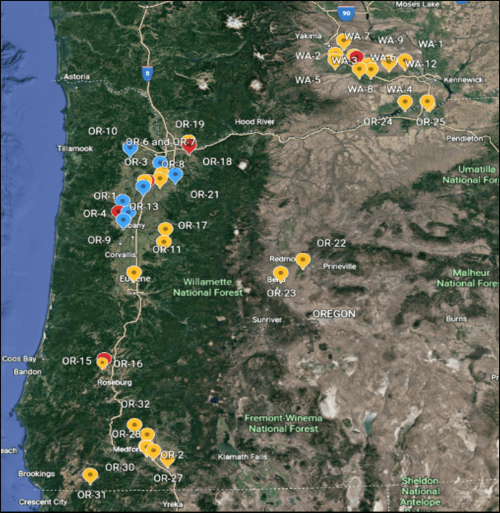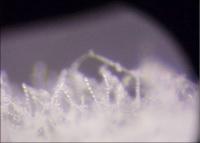Management of powdery mildew on hemp in the Pacific Northwest
Hemp (Cannabis sativa L.) is susceptible to fungal pathogens that incite powdery mildew.
Quick Summary
- Hemp (Cannabis sativa L.) is susceptible to fungal pathogens that incite powdery mildew.
The fungi that cause powdery mildew on hemp in the Pacific Northwest include Golovinomyces ambrosiae (G. ambrosiae) and Podosphaera macularis (P. macularis). During 2018 and 2019, western Oregon greenhouse hemp growers reported powdery mildew on leaves and buds of several hemp cultivars and the powdery mildew fungus was identified as G. ambrosiae.
Hemp (Cannabis sativa L.) is susceptible to fungal pathogens that incite powdery mildew.

In addition to infecting cannabis, G. ambrosiae can also infect members of the Asteraceae family and has been reported as causing disease on sunflower, dahlia, daisy, Jerusalem artichoke, zinnia and ragweed. Podosphaera macularis, an important pathogen on hop (Humulus lupulus L.), was reported to infect hemp following artificial inoculation in a greenhouse.
In 2020, OSU discovered infections of field-grown hemp by P. macularis in Oregon; it has also been reported on cannabis in Switzerland and Canada. Hemp plants in 43 fields with the majority located in the Willamette Valley in Oregon and the Yakima Valley in Washington where hops are also produced were surveyed for powdery mildew in 2021, starting shortly after transplanting as well as during mid- and late-season.
By the end of the growing season, powdery mildew was detected in 12 of 32 fields in Oregon and in one of the 11 sites in Washington. Golovinomyces ambrosiae occurred in all affected fields while P. macularis co-occurred in several fields in Oregon and in one site in Washington (figure 1). Powdery mildew was generally not detected in the 2021 hemp survey until plants had begun flowering.

Golovinomyces and Podosphaera produce copious amounts of asexual spores known as conidia, which are produced in chains (figure 2). The white powdery growth characteristic of powdery mildew on a hemp leaf is primarily due to these conidia, and colonies become visible 7 to 14 days after infection.
After release, conidia can be moved via wind currents, spreading the disease to neighboring leaves, plants or fields. Warm conditions are conducive for the production of conidia and subsequent infection of plants. The ideal temperature for conidial production by P. macularis on hop is close to 77°F while conidia production and infection of plants are inhibited when the ambient temperature exceeds 86°F.
It is anticipated that temperature effects would be similar for P. macularis on hemp. No information is available regarding temperatures conducive for sporulation and infection by G. ambrosiae.
These two fungi can also produce sexual spores (ascospores) in fruiting bodies known as chasmothecia, but evidence of ascospores in association with cannabis is lacking in the Pacific Northwest.

Podosphaera macularis has not been found to produce chasmothecia in hop production in the Pacific Northwest; only one of the two requisite mating types needed for sexual recombination is currently present in the region. Podosphaera macularis is known to overwinter as mycelium on infected crown buds of hop plants in the field.
These two powdery mildew fungi can also survive on infected plants in the greenhouse and may move from there to out-of-doors. For more information on powdery mildew on hemp, see the online Pacific Northwest Plant Disease Management Handbook.
Infection of hemp plants by these powdery mildew fungi can theoretically occur at any stage of plant growth.
Infections appear as whitish, powdery spots on the upper leaf surface (figure 3). Entire leaf surfaces can be covered with powdery mildew and petioles as well as flower bracts can also be infected. As foliar infections of Golovinomyces and Podosphaera age, if chasmothecia
were to be produced, they would become visible as the small, nearly spherical fruiting bodies turn from yellow to dark-brown or black within the patches of older powdery mildew colonies. If chasmothecia are found on hemp, please contact OSU.
Cultural management of powdery mildew
- Removal of infected leaves early in disease development can aid in delaying epidemics.
- Maintain adequate nitrogen levels but do not over-apply because more succulent tissue is more susceptible to infection.
Chemical control of powdery mildew
A protective spray program may be warranted, depending on cultivar susceptibility, the disease effect on the harvested product and tolerance levels for powdery mildew in products.
Thorough spray coverage is essential for protection. Apply fungicides before powdery mildew is present and the pathogen reproducing.
See the Oregon Department of Agriculture (ODA) hemp pesticide guide list.
- Bicarbonates such as Bi-Carb Old Fashioned Fungicide, Green Cure/Organic Production, Kaligreen, MilStop SP, etc. are listed for hemp on the ODA website. Several formulations are OMRI-listed and suitable for organically produced crops. Studies by the University of Tennessee showed good efficacy when bicarbonate was applied at weekly intervals on greenhouse-grown hemp.
- LifeGard WG for activating plant resistance; studies by the University of Tennessee did not show this product to be significantly better than nontreated plants. OMRI-listed.
- Oils including Bonide Bon-Neem II, Mildew Cure, Monterey Horticultural Oil, Omni Supreme Spray, etc. can help to control powdery mildew. Do not spray if the temperature is below 50°F or above 90°F or when plants are wet or under heat/moisture stress. Some formulations are OMRI-listed.
- Regalia can offer reasonable control of powdery mildew as shown by field and greenhouse studies conducted by the University of Tennessee. OMRI-listed.
- Sil-Matrix LC can help to control powdery mildew, spider mites and aphids, but studies by the University of Tennessee did not show this product to be significantly better than nontreated plants. OMRI-listed.
- Sulfur formulations (Safer Brand Garden Fungicide /Flowers Fruit & Veg. Conc, Bonide Tomato & Vegetable Conc. 3in1, etc.) can be very effective at controlling powdery mildew; a greenhouse study by the University of Tennessee showed good efficacy with sulfur applied on seven-day intervals. Sulfur is fungitoxic in its vapor phase and, therefore, is effective only when air temperatures promote volatilization. Sulfur volatilizes above 65°F but becomes phytotoxic above 95°F. Using it above 85°F is not recommended.
Biological control of powdery mildew
See the Oregon Department of Agriculture hemp pesticide guide list. Various formulations (Actinovate AG, Double Nickel LC, and Serenade Opti) are available in the Pacific Northwest but their efficacy is unknown. These are generally OMRI-listed.
Use pesticides safely!
- Wear protective clothing and safety devices as recommended on the label. Bathe or shower after each use.
- Read the pesticide label—even if you’ve used the pesticide before. Follow closely the instructions on the label (and any other directions you have).
- Be cautious when you apply pesticides. Know your legal responsibility as a pesticide applicator. You may be liable for injury or damage resulting from pesticide use.
